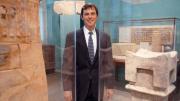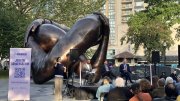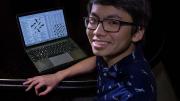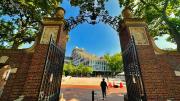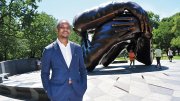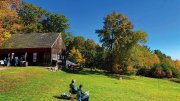In a glass case stand a dozen carved statues of gypsum alabaster male figurines with their hands folded at their chests and their shell-and-lapis-lazuli eyes wide open. Dating to around 2500 B.C., the statues were commissioned by wealthy Mesopotamians as proxy worshippers, to stand in the temples of gods and pray in their owners’ absence. “The Mesopotamians saw gods as present all around us,” explains Oriental Institute Museum director Geoff Emberling ’87. The gods were also believed to reside in their cult statues, he says, “so the idea that a person could be present in a statue is not so far removed.” The figurines and their role fascinate him because “they take us out of our way of seeing,” he explains, and provide “a good example of how, with a little understanding, we can glimpse” another world. Emberling, who has studied the ancient Near East for more than 20 years, has always tried to connect with that world.
When he arrived at the museum in May 2004, Emberling was part of Oriental Institute (OI) director Gil Stein’s strategy of recruiting “the smartest young people I can find and [giving] them a lot of responsibility.” The OI, a preeminent research center for Near Eastern scholars on the University of Chicago campus, has thousands of artifacts, most excavated between 1920 and 1940. “We dug this stuff ourselves,” Stein says. “We know exactly where it was found, what layer it was in, and what it was found with. You need a person with museum experience and also strong academic grounding as an archaeologist.” Emberling had both, and was thrilled to get the job, especially because the museum was about to reopen fully for the first time in a decade.
As director, Emberling’s top priority has been to communicate the importance of the ancient world to modern museumgoers, and he does so with expert showmanship. Leading a tour group of mostly older women one morning, he gestures widely, stretching his slim frame as he describes how bevel-rimmed clay bowls from 3500-2900 B.C. were found in Mesopotamia by the thousands, used “basically as paper plates” to feed the many royal workers. Stopping before a case filled with crude beige pots, he grins boyishly and says that this technological advance the pots were used for cooking grains created “a human health disaster” because the starch and sugar rotted people’s teeth. The group eats it up.
The OI Museum’s keepers didn’t always value public relations. The institute was founded in 1919 by archaeologist James Henry Breasted with help from John D. Rockefeller Jr. and was moved 12 years later to its current, Gothic home, which included a first-floor museum designed for scholars. The exhibit cases were crowded and dull. “The fact that the public wandered in was fine, but no one was going to engage them once they got here,” Emberling says. Today the institute and especially its museum consider outreach vital. By advertising in Chicago, conducting surveys and focus groups, and bumping up its publicity budget, the OI has increased attendance from 40,000 to 60,000 in the past three years. “If we don’t make a case for the relevance of the field,” Emberling says, “it will die.”
Not that he needs convincing. The ancient world has captivated him since the late 1970s, when he was 12 and his mother and stepfather took him to see the first-ever traveling King Tut exhibit, which had stopped in San Francisco, his hometown. “I was transported,” he says. Tut’s gold mask and shapely dagger, dramatically lit, exuded a sense of “quietness.” Realizing that this mummy was “still around 3,000 years later,” that he was witnessing a rare connection with the distant past, intrigued Emberling. He bought a book on the exhibit, ostensibly for his mother. “She never read it,” he says, “but I devoured it.” (He plans to take his own children to the current Tut exhibit, scheduled to open in Chicago in May.)
“There must be some psychological reason why some people are more attuned to the past,” he says, “but I don’t know what it is. Part of the excitement is being ‘taken away,’ a spirit of adventurousness.” While still in high school he joined an Earthwatch student dig, heading to Repton, England, to mine an Anglo-Saxon cemetery. “I was a horrible excavator, a disaster,” he says. “Twice I was scraping away with my trowel and found I had scraped the inside of a skull.”
Still, he stuck with archaeology. His Harvard application essay was “about how much I was interested in living in another culture, another place, seeing how people lived there.” Though Harvard had no Egyptology department, Emberling studied anthropology with C. C. Lamberg-Karlovsky, writing his honors thesis on Iranian carved-stone vessels dating to the third millennium B.C.
He also met Amy Leviten ’88, a fellow Winthrop House resident. One day in the dining-hall line, she began to tease him. Though he’s six-foot-three and she’s only five feet, it was he who looked “elflike,” with his “distinctive red cheeks and relatively turned-up ears,” she says with a laugh. “I tried to make him sing the jingle for Lucky Charms.” After college he took a year off, traveling to Europe, applying to graduate school, and working part-time in San Francisco. When Leviten graduated, they both moved to Ann Arbor, where she became a restaurant cook and he entered the University of Michigan to study with archaeologist Henry Wright. They married, at Wright’s suggestion, before Emberling took Leviten along on his first Middle Eastern dig, partly to avoid awkwardness in the conservative villages.
After spending much of 1989 traveling through Kashmir, digging in Turkey and Oman, and doing relief work in Africa, they returned to Michigan, where Emberling resumed his route to archaeology. He earned two master’s degrees, one in anthropology in 1991 and another in Near Eastern studies in 1994, and learned Sumerian and Akkadian cuneiform. “One thing I’ve always tried to do is be concerned about what it was like to be a person in these societies,” he says, rather than treat them as “abstract institutions.” Learning the languages was “another way of seeing the person in the past.”
In 1991 they headed to Paris, where Amy attended cooking school at the Ritz Hotel and Geoff found a collection of Iranian pottery at the Louvre to study for his dissertation. After finishing his doctorate in 1995, he and Amy went to Copenhagen, where he taught for a year. By then, the family had expanded to include children Jake and Ruby, and they all moved to New York City, where Geoff made a slight career switch, becoming assistant curator at the Metropolitan Museum of Art’s Department of Ancient Near Eastern Art. Even today he remains on the move, working in Chicago Monday through Thursday and driving three and a half hours each weekend back to the family in Ann Arbor, where Amy is managing partner of Zingerman’s Bakehouse.
From 1992 through 2004, while writing his dissertation, teaching, and curating, Emberling also joined, and in time became director of, a major archaeological dig Tell Brak, the ancient city of Nagar in northeast Syria, about 15 miles from the Iraqi border. While attending the International Congress of Assyriology and Near Eastern Archaeology in Paris, he had mustered the nerve to approach prominent British archaeologists David and Joan Oates. “I wanted to go and work on a big field project, a big site, where there would be a lot of spectacular finds,” he says. His passion won him a spot at the site, where the Oateses had been excavating since 1976.
At 40 meters high and a kilometer long, Tell Brak is one of the tallest archaeological mounds in the Middle East. Although surrounded by grassy fields and rich, red soil, it is a harsh place to live, even for two months each spring. Emberling lost 20 pounds during his first season, and when he returned, baby Jake didn’t recognize him. Still, Emberling embraced the place, making friends with the 100 local men who worked as laborers.
Meanwhile, the dig at Tell Brak, a pre-Akkadian and Akkadian site, revealed several treasures. In 1998 the team found a burned temple dating to 2400 B.C., the first of its kind found north of Baghdad. Between 1997 and 2000 they dug up a house from around 3700 B.C. with a long, narrow courtyard and a large domed oven, providing evidence that Tell Brak had developed at the same time as the earliest Mesopotamian cities, such as Uruk in southern Iraq. Emberling sees the dwelling as “the house of a sheik not a ruler, but a lower-level political figure who gave feasts for his followers.” Even now, he says, “When I go to visit a local sheik, he’s sitting at the end of a long narrow room, and visitors sit on the sides of the room. The architectural form is identical.”
As he alternated between Syria and the Met, Emberling learned the museum trade. He quickly determined that the Met valued art over history: it showcased fascinating objects but included “nothing about the people who made and used them.” So when Amy was offered the bakery position in Ann Arbor in 2000, he was ready to return to the Midwest. He became an independent scholar, teaching Near Eastern studies at Michigan, publishing articles, and writing grant applications for Tell Brak. But in 2003, when the Iraq war began, funding was held up and the University of Michigan, weathering the U.S. recession, canceled his adjunct-teaching position. “I had absolutely no income, no ability to carry out my work in the field.” He went back on the job market and, when employment seemed elusive, even contemplated leaving archaeology. Then the OI’s Stein, who’d known Emberling professionally (“The world of Near Eastern archaeology is fairly small,” Stein says), encouraged him to apply for the museum directorship.
The museum had closed its galleries in 1996, so workers could install climate-control systems. Since then, the refurbished, redesigned galleries have reopened, one at a time Egyptian (1999), Persian (2000), and Mesopotamian (2003). When Emberling arrived, planning was well underway for the Assyrian, Syro-Anatolian, and Megiddo galleries, which opened last January. His museum knowledge proved valuable: Stein credits him with engaging a design consultant “to give a similar look and feel to all of our galleries” and with saving the institute $100,000 by suggesting that a wall to hold Assyrian reliefs be built in-house.
Emberling is also linking the museum more closely to the contemporary world. The final exhibit hall, on Nubia (today part of modern Egypt and Sudan), opens in February. Highlighting Nubia’s ties to African Americans, Emberling has secured a Joyce Foundation grant to help local schoolchildren visit the museum to make their own Nubian “artifacts” and learn to give tours to classmates and parents. “The idea is to make local kids feel some ownership of the museum,” he explains. “I’m very excited about it.”
In addition, he has booked rotating exhibits a new concept for the OI through 2009; they include one on traditional Palestinian dress and another on printed maps of the Ottoman Empire. From here the job could move in several directions. He may focus on curating: the OI has thousands of objects in basement drawers that its registrar has estimated would take six people five years to document. He’d also like to finish writing up his Tell Brak discoveries and, with the OI’s sponsorship, continue making new ones. “I’d like the museum to become more of an active partner in the research of the institute,” he explains. He has sent three museum workers on field projects, and he hopes one day the museum itself will lead a dig.
He has also come to appreciate his forte for displaying and explaining the items he finds so fascinating. He’s even traveled to National Guard units nationwide to teach soldiers about Near Eastern artifacts and culture before they head to Iraq. “One of my strengths is working with people in groups on projects,” he says, rather than doing “the relatively solitary work of a researcher. I was late to realize that, but now that I’m here I can see how stimulating I find that process.” If recent tour groups’ enthusiasm is any indication, the stimulation is mutual.
~Amy Braverman
Amy M. Braverman is an associate editor at the University of Chicago Magazine.
